Vuelta a España 2020: Six things to look out for during the first week
Chris Froome, Thibaut Pinot and Primož Roglič all arrive with points to prove
Chris Froome's uncertain return
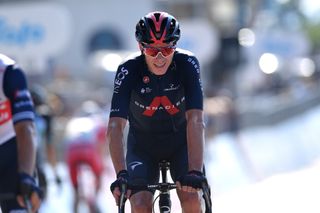
Is Chris Froome still capable of challenging at the highest level? That’s the big question ahead of the Vuelta a España, as he enters a Grand Tour for the first time since the horrific crash at the Critérium du Dauphiné that almost ended his career.
Prior to that crash, there were no signs at all that Froome was passing his peak years. Between 2016-2018, he produced an astonishing run of six consecutive podium finishes at Grand Tours, as well as becoming the first rider to hold all three titles since Bernard Hinault.
That was over two years ago, however, and Froome returns to the top level as an older man (he turned 35 in May) who has had to endure extensive rehabilitation just to be able to get back onto the saddle. He has always insisted that he’s capable of a comeback, and possesses the kind of dogged single-mindedness that make him impossible to write off, but there haven't yet been any glimpses this year of the old, all-conquering Chris Froome.
This will also be Froome’s swansong with Ineos Grenadiers, with whom he has enjoyed one of the great rider-and-team partnerships. They may have more faith in 2019 Giro d’Italia winner Richard Carapaz to lead their GC hopes, especially given his form in the final week of the Tour de France last month.
But even if Froome does end up riding as a domestique for Carapaz, how he performs will be a pivotal indication of whether he’ll still be a Grand Tour contender for new employers Israel Start-Up Nation next year.
Jumbo-Visma's formidable Tour line-up reassemble
Get The Leadout Newsletter
The latest race content, interviews, features, reviews and expert buying guides, direct to your inbox!
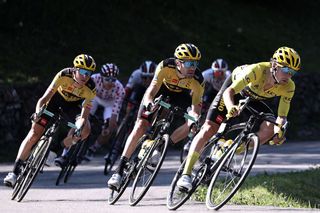
Still smarting from losing the yellow jersey at the last hurdle at the Tour, Jumbo-Visma go into the Vuelta a España desperate to put that disappointment behind them.
As a sign of how seriously they’re taking the Vuelta, they’re bringing pretty much the same team that was so impressive at that Tour de France, with the only changes seeing Wout van Aert, Tony Martin and Amund Grondahl replaced by Paul Martens, Lennard Hofstede and Jonas Vingegaard.
That means that Primož Roglič, Tom Dumoulin and Sepp Kuss will all again be present, and each looks like a potential overall winner. As defending champion, Roglič would be the most obvious leader of the three, although the physical and mental drain of defending the yellow jersey for so long may have taken too much of a toll. If that does prove to be the case, Dumoulin is a proven Grand Tour winner and seemingly back to near his best, while Kuss would no doubt relish the chance to ride as a leader having impressed so much in his super-domestique role.
Whoever ends up leading, Jumbo-Visma look set to again be the strongest team at this Grand Tour, with perhaps only Ineos Grenadiers and Movistar — who bring last year’s runner up Alejandro Valverde and their new young star Enric Mas — rivalling them.
An open race
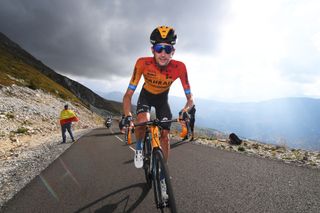
With the revised 2020 calendar seeing a clash between the Vuelta and the Giro d’Italia, and with several of the Tour de France not feeling fresh enough to take on another Grand Tour, this year’s Vuelta has a slightly lighter, more open field than we’ve grown used to in recent years.
That should give a chance for talented young riders who have been tipped as potential future Grand Tour contenders to compete for GC for the first time, and see what they can do over three weeks. 24-year-old Daniel Martinez’s (EF Pro Cycling) appearance will be especially anticipated, after he rode so well to win the Critérium du Dauphiné and a stage of the Tour de France; as will Astana’s Alexander Vlasov, who’s looking to bounce back after illness forced his Grand Tour debut at the Giro to come to an abrupt end.
Other riders who haven’t managed to put together a GC bid for several years, like Wout Poels (Bahrain-McLaren) and Esteban Chaves (Mitchelton-Scott), will hope to capitalise on the relative lack of experience in the field, while Guillaume Martin (Cofidis) will be looking to rediscover the form that saw him start the Tour de France so impressively.
Of most interest, though, will be how Thibaut Pinot’s race goes. The Frenchman cut a distraught figure when he tumbled out of overall contention at the Tour de France last month, even questioning his future in the sport. At his best, Pinot would be among the very top favourites for overall victory, but does he have the necessary motivation?
The hills of the Basque Country
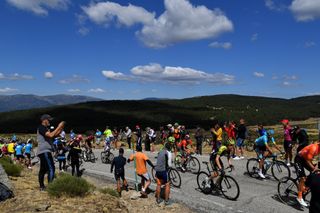
Anyone hoping to win the overall classification will have to be on their game from day one, as the first week — typical for a Vuelta — features more uphill finishes than it does sprint stages.
We begin in the Basque Country, with the region’s notoriously hilly terrain being fully put to use. Stage one finishes atop Monte Arrate, a steep climb that is a regular feature of the Tour of the Basque Country, while the riders will climb the first category San Miguel de Aralar the following day before a 17km descent to the finish.
Even when the race heads south into Castilla y Leon, the climbing doesn’t cease — in fact, the mountain that hosts the finish of stage three, to Laguna Negra de Vinuesa, is the toughest of the race so far.
There are some high-profile sprinters set to ride the Vuelta, most notably green jersey winner Sam Bennett (Deceuninck - Quick-Step) and the German Pascal Ackermann (Bora-Hansgrohe), but the race hasn’t attracted many — and it’s easy to see why looking at the parcours.
They’ll have to wait until stage four in Aragon for their first shot at a stage win, while the undulating terrain of the following day might make things too hard for them to control.
Puncheurs and climbers battle for stage wins
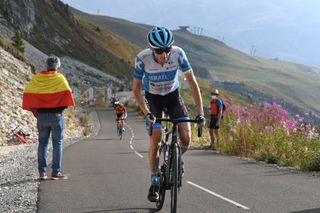
Instead, most of these opening week stages will be contested by puncheurs and climbers that manage to get into breakaways, as well as the GC contenders.
Some teams have selected multiple riders capable of attacking and winning on these early stages. Bahrain-McLaren, for instance, have both Dylan Teuns and Matej Mohorič who could excel on these punchy climbs, while Astana boast several options including Omar Fraile, Luis Leon Sanchez and rising star Alex Aranburu.
The start list is also full of climbers who might struggle on the longer, higher altitude mountains that await later in the race, but could match the favourites on these climbs and defeat them in a punchy sprint finish.
For instance, the likes of Dan Martin (Israel Start-Up Nation), Michael Woods (EF Pro Cycling) and Davide Formolo (UAE Emirates) are unlikely to be contenders for the red jersey, but are capable of winning stages on the smaller uphill finishes of this first week.
And on the less challenging climbs, such as those featuring on stage five, Classics specialists like Tim Wellens (Lotto-Soudal) are capable of going for glory.
Col du Tourmalet
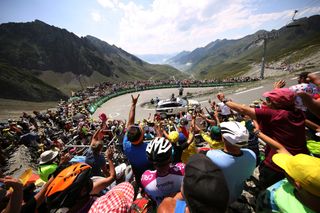
The most decisive battleground in the opening weekend of this year’s Vuelta a España won’t actually take place in Spain, but rather across the border in France, where the riders will take on the mythical Col du Tourmalet.
Although associated more closely with the Tour de France, the Tourmalet has featured in the Vuelta before, and this year the organisers have followed the example recently set by their French counterparts and will use it as a summit finish on stage six.
Unlike the other uphill finishes so far this week, the Tourmalet is a much longer effort, and reaches far higher altitudes, exceeding 2000 metres at the summit. On top of that, before reaching it the riders must first get over the comparatively hard Alto del Portalet and Col d’Aubisque, making today’s stage one of the hardest, and potentially most important, of the whole race.
Another complicating factor could be the weather. The mountain is not used to hosting racing this late into the autumn, and there have been fears that snowfall might make racing up it impossible. At the moment the forecast isn’t too bad, and indicates that the stage should be good to go ahead — but rainfall remains a distinct possibility, which would make matters even more unpleasant for the riders suffering up the fearsome mountain.

Thank you for reading 20 articles this month* Join now for unlimited access
Enjoy your first month for just £1 / $1 / €1
*Read 5 free articles per month without a subscription

Join now for unlimited access
Try first month for just £1 / $1 / €1
Stephen Puddicombe is a freelance journalist for Cycling Weekly, who regularly contributes to our World Tour racing coverage with race reports, news stories, interviews and features. Outside of cycling, he also enjoys writing about film and TV - but you won't find much of that content embedded into his CW articles.
-
 Lidl-Trek, EF Education-EasyPost among first teams to seize ‘the only chance to race in the United States’
Lidl-Trek, EF Education-EasyPost among first teams to seize ‘the only chance to race in the United States’With a world-class field of competitors, organisers hope to showcase professional cycling to American spectators and reignite fan interest
By Anne-Marije Rook Published
-
 'This sucks': Brixton Cycles closes its doors after 42 years
'This sucks': Brixton Cycles closes its doors after 42 yearsIconic London shop announces closure after premises listed on property site
By James Shrubsall Published